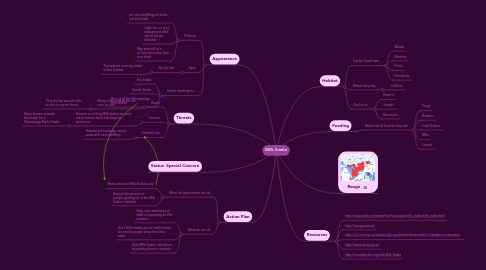
1. Appearance
1.1. Patterns
1.1.1. (tri-coloured)Rings of white, red and black
1.1.2. Light tan, or grey background with red or brown blotches
1.1.3. May start off as a tri-coloured baby, then turn black
1.2. Eyes
1.2.1. No eye lids
1.2.1.1. Transparent covering called brilles instead.
1.3. Similar markings to..
1.3.1. Fox Snake
1.3.2. Scarlet Snake
1.3.3. Most of all the Massassauga Rattlesnake
2. Threats
2.1. Roads
2.1.1. Many of the snakes are run over by cars
2.1.1.1. They do live around cities so this is a great threat
2.2. Humans
2.2.1. Humans are killing Milk Snakes because many humans think that they are poisonous
2.2.1.1. Many humans mistake this snake for a Masassauga Rattle Snake
2.3. Habitat Loss
2.3.1. Humans are replacing nature areas with new buildings
3. Action Plan
3.1. What the government can do
3.1.1. Make zones for Milk Snakes only
3.1.2. Reduce the amount of people getting rid of the Milk Snake's habitats
3.2. What we can do
3.2.1. Help raise awareness of what is happening to this creature
3.2.2. Since Milk Snakes are not well-known, we can let people know that they exist!
3.2.3. Help Milk Snake's reproduce by putting them in captivity
4. Status- Special Concern
5. Habitat
5.1. Can be found near
5.1.1. Woods
5.1.2. Marshes
5.1.3. Fields
5.1.4. Farmlands
5.2. Where they stay
5.2.1. In Barns
5.3. Can live in
5.3.1. Deserts
5.3.2. Jungles
5.3.3. Mountains
6. Feeding
6.1. What kind of food do they eat
6.1.1. Frogs
6.1.2. Rodents
6.1.3. Small Snakes
6.1.4. Mice
6.1.5. Lizards
